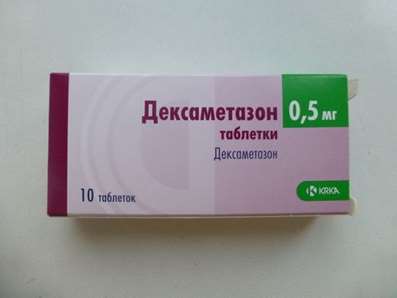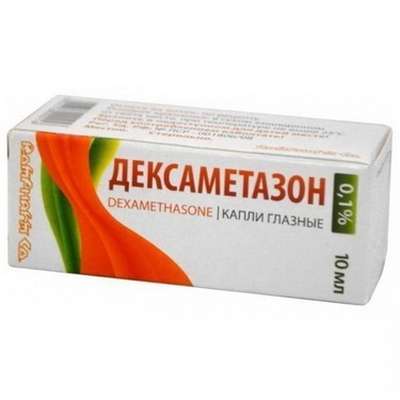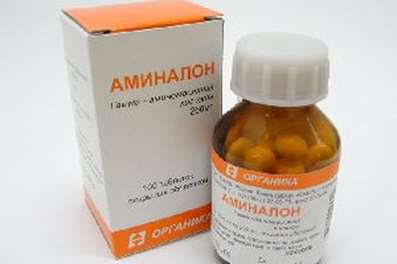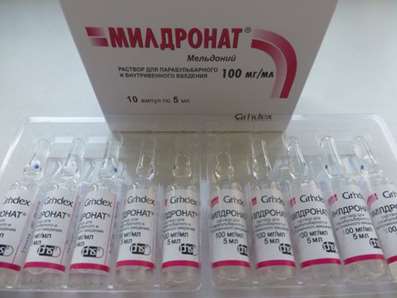Mildonium
28 Dec 2016
Mildonium (INN), trademarks Mildronat, Mildronāts, also known as Quaterine, Met-88 and THP - is the limited availability of the pharmaceutical drug market, designed in 1970 and manufactured by Ivar Kalvins first Latvian company Grindeks and some generic manufacturers. It is distributed in Eastern European countries as a medicine against ischemia. From 1 January 2016, the drug included in the list of the World Anti-Doping Agency of substances (WADA) prohibited for use by athletes. However, there is controversy about its use as a substance enhancing athletic performance. Some athletes are known to have used it before it was banned.
Systematic (IUPAC) name: 2- (2-carboxylate ethyl) -1,1,1-trimethylhydrazinium
Trade names: Mildronate
Number CAS 86426-17-7
Synonyms: THP, MET-8 Mildronāts or Quaterine
Formula: C6H15N2O2 +
Molar mass: 147.19 g / mol
Solubility in water:> 40 mg / mL mg / mL (20 ° C)
Medical use of Mildonium
Mildonium used in medicine for the treatment of angina and myocardial infarction. The first clinical trial of the effectiveness of using a combination of Mildonium and lisinopril, angiotensin converting enzyme inhibitor, for the treatment of chronic heart failure, was conducted in 2005. The test showed that the combination of lisinopril and Mildonium can improve the quality of life, exercise tolerance, as well as mechanisms of peripheral blood circulation in patients with chronic heart failure. Another research report in 2008 showed that the combination of lisinopril and Mildonium improved baroreceptor reflex in patients with chronic heart failure patients. In February 2010, a further clinical trial examining only patients with angina, tested the efficacy and safety of Mildonium in conjunction with standard measures to improve exercise tolerance. The study found that the drug significantly improved exercise capacity in stable patients with angina. Team of the Fourth Military Medical University, Xi'an, Shaanxi, China, conducted a clinical phase II trial involving 227 patients for efficacy and safety Mildonium in acute ischemic stroke, which was completed in August of 2013. The study authors concluded that Mildonium was as effective and safe as sinepazide injection.
Pharmacology of Mildonium
Mildonium inhibits oxidation of fatty acids, presumably by inhibiting the enzyme gamma-butyrobetaine hydroxylase Carnitine in the biosynthetic pathway. γ-butyrobetaine hydroxylase belongs to the superfamily of 2-oxoglutarate and oxygenase catalyzes the formation of L-carnitine from gamma-butyrobetaine. Despite the fact that the initial data suggest that Mildonium is non-competitive and not hydroxylated analogue of gamma-butyrobetaine, further research revealed that Mildonium is a substrate for the gamma-butyrobetaine dioxygenase. X-ray analysis and in vitro biochemical studies indicate that communicates with the pocket Mildonium substrate γ-butyrobetaine hydroxylase and acts as an alternate substrate, and therefore a competitive inhibitor. Typically, the action of this enzyme on its substrate and γ-butyrobetaine gives 2-oxoglutarate in the presence of additional oxygen substrates L-carnitine products, succinate and carbon dioxide; in the presence of an alternative substrate reaction produces semialdehyde malonic acid, formaldehyde (similar to the action of demethylases histones), dimethylamine and (1-methyl-imidazolidin-4-yl) acetic acid, "unexpected product with extra carbon-carbon bond, the resulting N demethylation coupled with oxidative rearrangement probably unusual via a radical mechanism. " In this unusual mechanism is probably involved regrouping Stephen. Inhibition meldonium γ-butyrobetaine hydroxylase gives the value of half-maximal inhibitory concentration (IC50) 62 micromolar, that other authors of the study described as "potent." Mildonium is an example of an inhibitor which acts as simulant non-peptidyl substrate. The other primary study showed reports (nuclear magnetic resonance), which also binds to Mildonium acetyltransferase carnitine, a ubiquitous enzyme that plays a role in cellular energy metabolism; it also inhibits this enzyme, although slightly more (the inhibition constant, Ki, 1,6 mmoles).
Physical and chemical properties of Mildonium
Chemical name Mildonium - 3- (2,2,2-trimethyl-Imil hydrazinium) propionate. This substance is a structural analog of gamma-butyrobetaine with amino replacing C-4 methylene γ-butyrobetaine. γ-butyrobetaine is a precursor in the biosynthesis of carnitine.
Society and Culture
dope
Mildonium was added to the list of prohibited substances World Anti-Doping Agency (WADA), starting from January 1, 2016, due to evidence of its use by athletes to enhance performance. Mildonium was on the list of preparations for the WADA monitoring 2015. WADA classifies preparation as metabolic modulator, as well as insulin.
Victims of Mildonium
March 7, 2016, the former world champion tennis player and world number one Maria Sharapova announced that she failed a doping test in Australia due Mildonium detection. She said she took the drug for a decade to treat a variety of health problems, and did not notice that he was listed as banned. Earlier in the day, Russian figure skater Ekaterina Bobrova announced that it has also been tested positive on Mildonium at the European Figure Skating Championships in 2016. Bobrov was "shocked" by the results of the test, because she knew that Mildonium included in the list of banned substances, and avoid foods that contain banned substances. Other athletes who are temporarily forbidden to participate in the competition due to the use Mildonium - Swedish middle distance runner of Ethiopian origin Abeba Aregawi, Ethiopian long-distance runner Endeshaw Negesse, Russian cyclist Eduard Vorganov and Ukrainian biathletes Olga Abramova and Artem Tishchenko. World Anti-Doping Agency has recorded 110 positive samples with traces Mildonium in the period from January 1 to March 10.
Disputes about Mildonium
A study in December 2015, published in the «Drug Testing and Analysis» magazine says that Mildonium "shows an increase in performance and endurance in athletes, faster rehabilitation after training, protects against stress and improves the function of the activation of the central nervous system (CNS)» . The manufacturer, the company of Grindex, said he did not think that the use of Mildonium should be prohibited for athletes. The company said that the drug acts primarily by reducing cell damage that can be caused by some of the by-products of carnitine. Mildonium "is used to prevent ischemic cell death, and not to increase the performance of normal cells," the statement said. "Mildonium can not improve athletic performance, but it can stop tissue damage in the case of ischemia," that is, when there is insufficient blood flow to the heart. The drug was invented in the mid-1970s at the Institute of Organic Synthesis of the Academy of Sciences of the Latvian SSR Ivars Kalvins. Kalvins criticized the ban, saying that WADA did not provide scientific evidence that the drug can be used as doping. According to him, Mildonium does not improve athletic performance, and most have been used by athletes to prevent damage to the heart and muscles, caused by lack of oxygen during high-intensity exercise. He argued that not allowing athletes to take care of your health is a violation of human rights, and that the decision was taken or because of prejudice against athletes from Eastern Europe or in order to reduce competition in the competition. Liene Kozlovsky, head of anti-doping department of the Latvian Centre for Sports Medicine, has rejected the allegations that the ban is a violation of the rights of athletes, saying that Mildonium dangerous in large doses, and should be used only under medical supervision for the treatment of real health problems. She also suggested that the Russian athletes have not received adequate warning that the drug was banned due to the suspension of the anti-doping agency of the Russian Federation at the end of 2015. Forbes reported that a professor of anesthesiology Michael Joyner of the Mayo Clinic in Rochester, Minnesota, studied how people respond to the physical and mental stress during exercise and other activities, said that "there is insufficient evidence regarding the actions of many of the compounds that are expected improve athletic performance. Their use has something in common with urban legends, and it is unclear whether these products really effective. I would be shocked if he knew that this substance (Mildonium) has efficacy above caffeine or creatinine (a natural substance, which, if taken as a supplement, supposedly, helps to increase muscle mass). " Ford Vox, a doctor from the United States, specializing in regenerative medicine and journalist, said that "there is not much scientific evidence to support the use of this substance as an athletic performance booster."
Member approval of Mildonium
Mildonium that is not approved by the FDA in the United States, is a registered prescription drug in Latvia, Russia, Ukraine, Georgia, Kazakhstan, Azerbaijan, Belarus, Uzbekistan, Moldova and Kyrgyzstan.
Available forms of Mildonium
Mildonium sold in capsules in 250 mg and 500 mg, and a 10% Mildonium solution for injection.
Economy of Mildonium
Mildonium made of Grindex Company, the Latvian pharmaceutical company, which has offices in thirteen countries of Eastern Europe, as a means for the treatment of heart disease. Company identifies it as one of its main ingredients. In 2013, its sales amounted to 65 million euros.

 Cart
Cart





